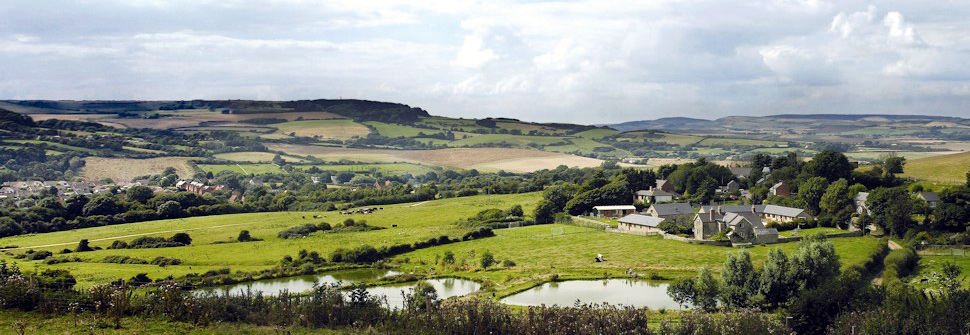Totland
The name Totland means the "protruding, prominent land", or "look-out land", and in olden days there was a beacon on the cliff which was lit when danger threatened. This defensive measure may date back to Anglo-Saxon times. Colwell Bay and Farm appear in 1417 as "Colewhelle", and a possible explanation of the name is "the cool well", referring to one of the cold springs in the Bay.
Few ancient buildings remain in the district; at Colwell the oldest are Rockstone Cottage (c. 1790); Willow Cottage and Colwell Cottage; and in Totland there is Windmill Farm House. In Napoleonic times troops were encamped on Colwell Common. The Officers' Mess was at Rockstone Cottage and the cooking was done in the barn, now Barncroft. Later on, gipsies camped on the Common and down Colwell Chine. Weston Manor was built in 1871, on the site of older houses dating from Edward I. It is now run as a Home for mentally handicapped men and youths. In the chapel, recently restored, there is a ceiling painting of Christ on a rainbow. Weston Farm dates back to the 1700s.
Money from Squire Ward's Trust built St. Saviour's Roman Catholic Church on manor land some fifty years ago. At Christchurch, Totland, the lych-gate is built of timbers taken from H.M.s. Thunderer, 74 guns, which fought in the line at Trafalgar. The last smuggler was caught 80 years ago, at York Farm, Highdown. Kegs of brandy had been concealed in a pond, but they were found and the farmer, Mr. Simmonds, was fined £100 and his vessel confiscated. On another occasion two kegs of brandy were to have been taken to Newport hidden in sacks of potatoes, but the Excisemen got wind of this. Warned that a search was about to be made the carrier's wife, who lived at Kippax, Camp Road, hastily prepared a tub and stood there doing the washing with the kegs hidden under her ample petticoats, while vain search was made of the house and outbuildings.
The first Lifeboat at Totland was called The Little Dove, and was subscribed for by all the Island Sunday-School children. It was stationed at Totland until, in 1884, the first R.N.L.I. boat, the Charles Luckhombe, came on station. After many years William Conway was detailed by the R.N.L.I, to tour Britain and select a suitable type of boat for this coast. The choice was the Robert Fleming, only replaced in 1924 by the modern Lifeboat at Yarmouth.
A memorial to the Lifeboatmen was unveiled in the Totland Parish Hall, on January 10th, 1974, and Jack Conway, last surviving member of the crew, was present.
On July 20th, 1910, Mr. Loraine, the actor-manager, made a return flight across the Solent. He took off in his Farman biplane at about 6.30 p.m, from Needles Point Cliff above Alum Bay, and, after flying over Yarmouth, he attained an altitude of 1,500 feet, and reached Bournemouth in less than half-an-hour.
The old Needles Lighthouse was erected on the cliff-top in 1781, and was replaced by the present one in 1858. It is interesting that the crews' quarters were removed bodily from the cliff and re-erected as Sunny Cottages in Summers Lane.
In April, 1897, Signor Marconi walked into Totland Bay Post Office and asked Mr. Garlick, the Postmaster, for assistance in his experiments in transmitting wireless messages. Helped by Mr. Garlick, he set up his transmitting station at the Royal Needles Hotel, erecting a huge mast which had come from the Royal Yacht Britannia. Messages were sent at first a distance of one mile to Totland, then eighteen miles out to sea to the steamer Mayflower. Finally the U.S. St. Paul picked up a message thirty-six miles off the Needles. A memorial to this event stands at Alum Bay.
Shepherd Paul, who lived in a small flint cottage under Highdown, tended the Farringford flock for Alfred, Lord Tennyson. The poet spent many hours talking to this unlettered but interesting and imaginative old man. He was the soul of thrift, and from his meagre farm-worker's pay contrived to leave behind him a memorial which remains today – the Shepherd Paul Trust, administered by the Freshwater and Totland Parochial Councils, "to give bread to the poor and needy of the Parishes".
Totland is the H.Q. for the Needles District of H.M. Coastguard, and is a "Constant Watch" station, with a Coastguard on duty at the Needles Look-out and Housing Station at all times. The Needles Station is the liaison between the Coast Radio Station at Niton and all districts between Dover and Plymouth; the crew are sometimes called out to cliff incidents.
Trinity House Pilot Vessels now operate from Yarmouth, but still tie up for short periods at Totland Pier. At the State Funeral of Sir Winston Churchill (an Elder Brother of Trinity House) the Totland Pilot Vessel Landward led Havengore bearing the coin, in the procession up the Thames.
Among celebrated residents was George Frederick Watts, painter, sculptor and prophet, who built "The Briary" for his friends, Mr. and Mrs. Princep; this house was destroyed by fire, but the studio escaped and forms part of the new house built in Georgian Colonial style. Mrs. Julia Cameron, the gifted pioneer of portrait photography, and a quite remarkable number of writers have at different times been residents of Totland; and Alfred Noyes, the poet, who died in 1958, is buried in St. Saviour's churchyard.

